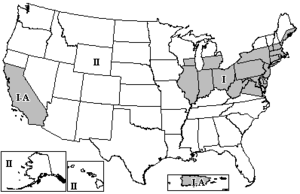FM broadcasting in the United States
FM broadcasting in the United States began in the 1930s at engineer and inventor Edwin Howard Armstrong's experimental station, W2XMN.
In October 1937, the Federal Communications Commission (FCC) announced new frequency allocations, which included a band of experimental and educational "Apex" stations, that consisted of 75 channels spanning from 41.02 to 43.98 MHz.
In 1937 the Yankee Network, looking to eventually establish commercial FM operations, was granted a construction permit for an experimental station, W1XOJ, in Paxton, Massachusetts.
The first publicized W2XMN broadcast took place on July 18, 1939, which used a high-quality phone line link to rebroadcast a program from WQXR in New York City.
[9] There was significant interest in the new FM band by station owners, however, construction restrictions that went into place during World War II limited the growth of the new service.
One area of concern was the effects of tropospheric and Sporadic E propagation, which at times reflected station signals over great distances, causing mutual interference.
A particularly controversial proposal, spearheaded by the Radio Corporation of America (RCA), which was headed by David Sarnoff, was that the FM band needed to be shifted to higher frequencies in order to avoid this potential problem.
In the early 1960s, FM began to benefit from increased investment, as broadcasters looked to it to expand their markets; television had been built out by this point, and the shift to music as the dominant format of AM in the wake of television and the rise of rock 'n' roll had led to an AM band so crowded that the FCC was limiting many stations to daytime-only operation, a restriction to which FM was not subject.
This spacing was developed in response to problems perceived on the original FM band, mostly due to deficiencies in receiver technology of the time.
Other spacing restrictions relate to mixing products with nearby television, air-traffic control, and two-way radio systems as well as other FM broadcast stations.
In some "Twin city" markets close to the Canada–United States or Mexico–United States border, such as Detroit, Michigan, and Windsor, Ontario, or San Diego, California, and Tijuana, Baja California, commercial stations operating from those countries target U.S. audiences on "reserved band" channels, as neither Canada nor Mexico has such a reservation.
These regulations (see Docket 80-90) have resulted in approximately double the number of possible stations, and increases in allowable power levels, over the original bandplan scheme described above.
This huge power level does not usually help to increase range as much as one might expect, because VHF frequencies travel in nearly straight lines over the horizon and off into space.
